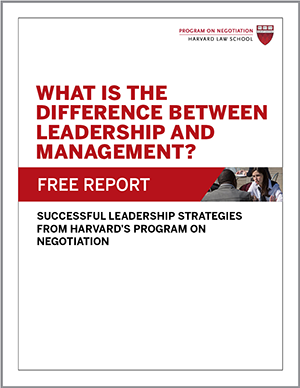
Black men and women continue to be vastly underrepresented in leadership roles in corporate America. Those who advance in majority-white organizations encounter both covert and overt bias, and often struggle to feel authentic and connected. The Program on Negotiation’s Negotiation Briefings newsletter spoke with University of Virginia Darden School of Business professor Laura Morgan Roberts, co-editor of Race, Work & Leadership: New Perspectives on the Black Experience (Harvard Business Review Press, 2019), about the negotiation and leadership skills needed for organizations to achieve greater inclusion.
Negotiation Briefings: Overt discrimination aside, what unconscious biases do interviewers display toward black applicants during the hiring process?
Laura Morgan Roberts: Some of the unconscious biases that lead to lower likelihood of black applicants being hired and black workers being promoted include very subtle cues about racial identity, such as having a black-sounding name. For instance, if two résumés are identical except for the name on top, the résumé with the black-sounding name is much less likely to be selected, Marianne Bertrand [University of Chicago] and Sendhil Mullainathan [MIT], as well as others, have found in their research. When black applicants show up for the interview, certain racial cues are penalized, including hairstyles. People who have an “ethnic” hairstyle are judged as being less professional and are less likely to receive opportunities, Tina Opie [Babson College] and Katherine Phillips [Columbia Business School] and others have found in their work.
NB: How can interviewers overcome some of these unconscious biases when making hiring decisions?
LMR: First, by naming them. Race is a scary topic, and being perceived as racist in any form is deeply threatening to the ego and psyche of members of dominant groups, especially white leaders. So the tendency is to shy away from conversations about implicit biases that disadvantage black candidates and leaders. When we name them, we have a greater opportunity to pause before making assumptions.
Second, when evaluating a candidate’s profile, it’s important to recognize the various obstacles that many African American candidates had to traverse to get to where they are. For instance, when you’re evaluating two graduates from an MBA program, look not only at their degree and class placement but also at their journey to and through the entire educational system.
Metaphorically speaking, one student may have traveled on a smooth road with a prepaid gas card; the other student may have traveled on a dirt road and had to stop to work to buy more gas. People often debate which students have access to greater or less privilege. In many cases, racial prejudice constitutes a bumpy dirt road. This doesn’t mean you have to lower the bar for a black student who traveled this road. Rather, it means respecting and recognizing the incredible talent, endurance, and ingenuity that many African American leaders have displayed for years before they even show up at the hiring organization—and viewing it as a source of strength.
NB: What hurdles do black leaders in particular face in their organizations as a result of their race, and how might they negotiate to overcome them?
LMR: One is the experience of trying to navigate your own career path in an organization where you’re a numerical minority. In those situations, black employees feel more pressure to behave in inauthentic ways at work. They may feel they need to modify their appearance or what they share about their interests and families, and so forth, if they believe those attributes will be stigmatized, research by Courtney McCluney of the University of Virginia shows. On a personal level, I have had to learn how to negotiate with myself about my own identity and the tradeoffs I’m willing to make for the sake of advancement. We’ve heard many black leaders strategize about that type of agentic and calculated processing—which is often fraught with tension but also sometimes rather empowering. Black employees are making a set of decisions about what aspects of their racial identity they want to share at work and which they would rather not. They have to decide what tradeoffs feel most ethical, comfortable, and sustainable for them.
The other hurdle that African American leaders often have to negotiate has to do with taking on different types of job opportunities. In our book, Cornell dean Lynn Perry Wooten and Emory dean Erika Hayes James describe their research showing that African Americans are disproportionately more likely than whites to be offered and to accept “glass-cliff” CEO assignments—risky leadership positions that involve managing organizations in crisis. Again, those are tradeoffs African Americans are making to have the opportunity to lead.
NB: In your book, Harvard professor Henry Louis Gates Jr. writes about the successful efforts of the founders of Harvard Business School’s African American Student Union to increase the representation of black students at the school in the late 1960s. But the onus shouldn’t just be on minorities. What can those in the majority do to increase diversity and inclusion in their organizations?
LMR: Our book highlights three key roles that guide the pathway toward change and that ultimately have to work together. The first key role is that of the bottom-up outsider advocate—those students who took matters into their own hands and said, “We’re tired of hearing that you can’t find qualified applicants. Just give us the support and resources, and we’ll show you how it’s done.”
The second key role is top-down, at the C-suite level. Diversity and inclusion research shows that senior management has to be onboard in a genuine and sincere way. All large corporations today have some kind of language around inclusion, but when it comes down to making real change to corporate culture, nothing really happens. People who are in positions of power have to take public leadership actions to shape the culture, determine the reward systems, and place a higher premium on diverse talent.
The third key role is that of ally. White partners need to have a level of humility that communicates they don’t know everything about the black experience but are interested and open to learning. They also need to take ownership of the problem, so it’s not just thrust upon the shoulders of the person on the margins. Allies’ most important role is as bridge builders to the dominant group. Many folks in power get fixated on retaining their power, so they presume that inclusion is a zero-sum game—“Why should I give up my seat at the table?” White allies can help organizational stakeholders view inclusion as akin to integrative bargaining, not distributive bargaining.
For example, how can we expand our resources to maximize diverse human potential? Then white allies can articulate the BATNA of failing to change: For people on the margins, what are the costs of homogeneity, exclusion, and identity suppression in organizations? Why would the CEO care if these individuals are less represented and included? Organizations often fail to articulate what they like about their BATNA—the status quo. Allies can help drive that conversation.
What leadership skills have you found to be effective in promoting workplace diversity, equity, and inclusion?





